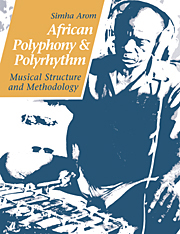Book contents
- Frontmatter
- Contents
- List of illustrations
- Foreword by György Ligeti
- Preface
- Acknowledgements
- BOOK I THE MUSIC OF THE CENTRAL AFRICAN REPUBLIC
- Map
- 1 General introduction
- 2 The general features of traditional music
- 3 Typology
- BOOK II AFRICAN POLYPHONIC MUSIC
- BOOK III TECHNICAL TOOLS: METHODS OF RECORDING POLYPHONIC MUSIC FOR TRANSCRIPTION
- BOOK IV THEORETICAL TOOLS
- BOOK V THE ORGANISATION OF TIME IN AFRICAN MUSIC
- BOOK VI STRUCTURAL PRINCIPLES AND THEIR APPLICATION
- Conclusion
- Bibliography
1 - General introduction
Published online by Cambridge University Press: 27 January 2010
- Frontmatter
- Contents
- List of illustrations
- Foreword by György Ligeti
- Preface
- Acknowledgements
- BOOK I THE MUSIC OF THE CENTRAL AFRICAN REPUBLIC
- Map
- 1 General introduction
- 2 The general features of traditional music
- 3 Typology
- BOOK II AFRICAN POLYPHONIC MUSIC
- BOOK III TECHNICAL TOOLS: METHODS OF RECORDING POLYPHONIC MUSIC FOR TRANSCRIPTION
- BOOK IV THEORETICAL TOOLS
- BOOK V THE ORGANISATION OF TIME IN AFRICAN MUSIC
- BOOK VI STRUCTURAL PRINCIPLES AND THEIR APPLICATION
- Conclusion
- Bibliography
Summary
GEOGRAPHICAL SURVEY
The area with which we are concerned is the former Oubangui-Chari, which became the Central African Republic in 1958. It is situated between the second and the eleventh degree of latitude north and between the fourteenth and twenty-eighth degree of longitude east. Neighbouring states include Chad to the north, Sudan (ex-English Sudan) to the east, Cameroon to the west, and the People's Republic of Congo and Zaïre to the south.
From east to west, the Central African Republic measures 1200 kilometres by 600 kilometres and occupies a quadrilateral of 617,000 square kilometres, a surface area roughly equal to that of France and of the three Benelux countries.
The course of the river Ubangi, joined by the Mbomu forms its Southern frontier. Together with the Congo, of which it is a tributary, the Ubangi (which is navigable as far as the capital, Bangui) connects the country to the Atlantic. Two mountain masses, to the east (Fertit, whose highest point is 1,400 metres) and to the west (Yade, 1,420 metres), frame a vast plateau, whose attitude averages 600 to 700 metres. Separating the two basins of the Congo to the south, and of the Chad to the north, this plateau is traversed by numerous important watercourses, which serve as channels of communication and, in former times, of migration.
It is usual to distinguish between four different geographical zones. From south to north, we find:
(1) in the far south, a zone of equatorial forest
(2) from the south to the centre, a zone of shrubby savannah, transected by strips of forest that follow the watercourses
(3) from the centre to the north, a zone of savannah that becomes more and more arid
(4) in the far north, a Sahellian zone.
- Type
- Chapter
- Information
- African Polyphony and PolyrhythmMusical Structure and Methodology, pp. 3 - 6Publisher: Cambridge University PressPrint publication year: 1991



